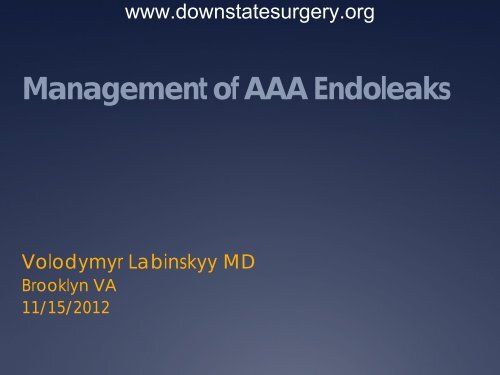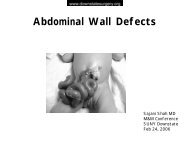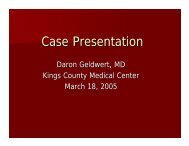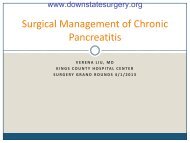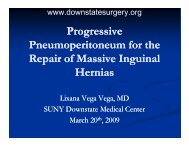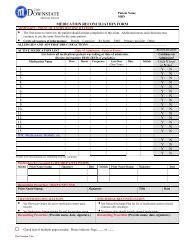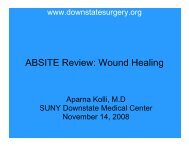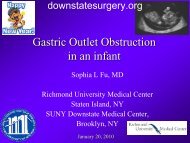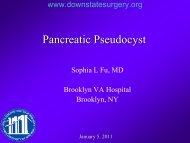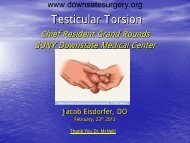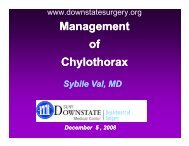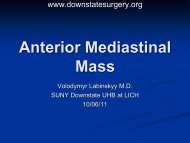Management of AAA Endoleaks
Management of AAA Endoleaks
Management of AAA Endoleaks
Create successful ePaper yourself
Turn your PDF publications into a flip-book with our unique Google optimized e-Paper software.
www.downstatesurgery.org<br />
<strong>Management</strong> <strong>of</strong> <strong>AAA</strong> <strong>Endoleaks</strong><br />
Volodymyr Labinskyy MD<br />
Brooklyn VA<br />
11/15/2012
www.downstatesurgery.org<br />
‣ 80 year old male presented with left groin pain, found to have a left<br />
groin hernia. On abdominal CT was incidental finding<br />
<strong>of</strong> expanding <strong>AAA</strong>.<br />
‣ PMH: HTN, hyperlipidemia, chronic renal insufficiency, lower limb<br />
neuropathy, colonic polyps, glaucoma, Hep C, hepatocellular<br />
carcinoma<br />
‣ PSH: CABG (1987), hepatectomy (2005), chemoembolizations, left<br />
inguinal hernia repair (2006), EVAR (2007), endoleak repair (2010),<br />
TURP (2006)
www.downstatesurgery.org<br />
Family History:<br />
-Father died <strong>of</strong> MI at age 44<br />
Social History:<br />
-1.5 pack per day, 25 years history <strong>of</strong> smoking cigarettes,<br />
quit 40 years ago<br />
Vitals: BP 168/86; HR 68; RR 18; sat 98%; T 97.6<br />
Labs:<br />
CBC 5.2/10.4/29.3/84<br />
BMP: 140/4.1/104/30.0/27/1.1/95
www.downstatesurgery.org<br />
Abdominal CT
www.downstatesurgery.org<br />
Angiogram
www.downstatesurgery.org<br />
Angiogram 2
www.downstatesurgery.org<br />
Angiogram 3
www.downstatesurgery.org<br />
Angiogram 4
www.downstatesurgery.org<br />
Angiogram control
www.downstatesurgery.org
www.downstatesurgery.org<br />
Currently, 5 endovascular stent-grafts are<br />
approved for<br />
clinical use in the United States.<br />
‣ Zenith® (Cook Medical Inc.; Bloomington, Ind)<br />
‣ AneuRx® <strong>AAA</strong>dvantage (Medtronic, Inc.;<br />
Minneapolis, Minn)<br />
‣ Gore Excluder® <strong>AAA</strong> Endoprosthesis (W.L. Gore<br />
& Associates, Inc.; Flagstaff, Ariz)<br />
‣ Powerlink® (Endologix, Inc.; Irvine, Calif)<br />
‣ Talent (Medtronic)
www.downstatesurgery.org<br />
EVAR can have a high incidence <strong>of</strong><br />
postprocedural complications<br />
‣ endoleaks<br />
‣ separation <strong>of</strong> modular components<br />
‣ aneurysm enlargement<br />
‣ stent or hook fractures<br />
‣ distal migration <strong>of</strong> the endograft
www.downstatesurgery.org<br />
Unfavorable neck anatomy:<br />
‣ angle >60 degrees<br />
‣ length
www.downstatesurgery.org<br />
Importance<br />
‣ Continued growth <strong>of</strong> the aneurysm sac is<br />
associated with a risk <strong>of</strong> rupture<br />
‣ Mortality <strong>of</strong> ruptured aneurysm following EVAR is<br />
equivalent to mortality <strong>of</strong> patient without EVAR<br />
-18 patients with EVAR/233 patients without EVAR<br />
-in-house mortality 38.9% vs 38.1%<br />
Cho JS at all, Vasc Surg, 2010 Nov
www.downstatesurgery.org<br />
Surveillance following EVAR<br />
Controversial roles<br />
Contrast enhanced CT/Non-contrast enhanced CT<br />
MRA/MRI<br />
Doppler ultrasound<br />
Contrast enhanced ultrasound<br />
Follow-up schedule:<br />
-1 month/6 month/1 year and annual after that
www.downstatesurgery.org<br />
Incidence <strong>of</strong> <strong>Endoleaks</strong> Requiring<br />
Intervention<br />
Overall incidence <strong>of</strong> endoleaks ranges from 20 to<br />
40%<br />
Endoleak type Eurostar n=2463<br />
(2002)<br />
Mehta et al<br />
n=1768 (2010)<br />
1 297/2463 (12%) 51/1768 (2.8%)<br />
2 191/2463<br />
(7.7%)<br />
136/1768<br />
(7.7%)<br />
3 297/2463 (12%) 5/1768 (0.3%)<br />
5 8/1768 (0.4%)
www.downstatesurgery.org<br />
Types <strong>of</strong> endoleaks<br />
‣ Type 1: Leak from endograft fixation point<br />
‣ Type 2: Leak from arteries arising from sac<br />
‣ Type 3: Leak from graft defect or modular<br />
junction<br />
‣ Type 4: Graft porosity<br />
‣ Type 5: Endotension/origin variable
www.downstatesurgery.org<br />
Types <strong>of</strong> endoleaks
www.downstatesurgery.org<br />
Type 1 endoleak<br />
Subgroups<br />
‣ -1A Proximal fixation<br />
‣ -1B Distal fixation<br />
‣ -1C around iliac occluder for monoiliac EVAR<br />
High pressure<br />
Associated with rupture<br />
Treated by:<br />
graft extencion<br />
ballon expandable stents<br />
embolization
www.downstatesurgery.org<br />
Type 2 endoleak<br />
‣ Subgroups<br />
‣ 2A single artery<br />
(simple)<br />
‣ 2B multiple arteries<br />
(complex)
www.downstatesurgery.org<br />
Type 2 endoleak: treatment<br />
‣ If aneurysm is stable or diminished in size,<br />
continued follow-up without intervention<br />
‣ If aneurysm increasing in size,<br />
embolization should be attempted<br />
‣ Embolization will fail unless the sac (which<br />
acts similar to a nidus in an AVM) can be<br />
reached<br />
‣ Embolization will be successful if inflow,<br />
sac and outflow can be occluded
www.downstatesurgery.org<br />
Type 2 endoleak: embolization<br />
‣ Embolic materials:<br />
- Coils<br />
- N-isobutyl-cyanoacrilate (glue)<br />
- Thrombin<br />
- Onyx (ethylene-vinyl alcohol polymer)<br />
- Gelfoam<br />
- Fibrin glue
www.downstatesurgery.org<br />
Type 2 endoleak embolization<br />
‣ If transarterial<br />
embolization is<br />
unsuccessful, then<br />
translumbar<br />
embolization<br />
should be<br />
performed
www.downstatesurgery.org<br />
Type 2 endoleak: results <strong>of</strong><br />
therapy<br />
‣ 42 patients with type 2 endoleaks and serial<br />
enlargement <strong>of</strong> the aneurysm sac<br />
‣ 49 procedures<br />
‣ 44 translumbar embolization with glue and coil<br />
‣ 9 IMA embolizations<br />
‣ 7 iliolumbar or hypogastric embolizations<br />
Average follow-up following treatment 23 months<br />
-Persistent or recurrent endoleak observed in 70%<br />
-No change in aneurysm growth pre and post<br />
treatment<br />
Aziz A et al, J Vasc Surg, 2012
www.downstatesurgery.org<br />
Type 2 endoleak: results <strong>of</strong> therapy<br />
‣ 95 patients underwent 140 embolizations<br />
‣ Coils, glue, gelfoam<br />
‣ Univariate analysis<br />
‣ Smokers more likely to have continued sac enlargement<br />
‣ Patients with hyperlipidemia more likely to fail<br />
Freedom from sac expansion >5 mm was 44% at 5 years<br />
Sarac TP, J Vasc Surg, 2012
www.downstatesurgery.org<br />
Type 3 endoleak<br />
‣ Subgroups<br />
‣ 3A junctional<br />
separation<br />
(modular devises)<br />
‣ 3B endograft<br />
fracture or<br />
perforation<br />
Minor 2 mm
www.downstatesurgery.org<br />
Type 4 endoleak<br />
‣ Endograft fabric porosity<br />
‣ Usually observed angiographically at the time <strong>of</strong><br />
implantation<br />
‣ Spontaneous resolution<br />
‣ No treatment necessary
www.downstatesurgery.org<br />
Type 5 endoleak<br />
‣ Subgroups<br />
‣ Occult leak due to very slow flow<br />
‣ Accumulation <strong>of</strong> serous fluid within the successfully<br />
excluded aneurysmal sac<br />
Incidence 1% to 5%<br />
Van Marrewijk et al, J Vasc Surg, 2002 Mar
www.downstatesurgery.org<br />
Type 5 endoleak: significance<br />
‣ Depend if cause is occult leak or sac hygroma<br />
‣ Occult endoleaks may present with life threatening<br />
bleeding following rupture<br />
‣ Rupture without hemodynamic instability has also<br />
been reported from sac hygroma
www.downstatesurgery.org<br />
Type 5 endoleak: treatment<br />
‣ Translumbar aspiration has been reported to be<br />
successful <strong>of</strong> hydromas<br />
Cerna M et al, J Vasc Surg, 2009 Sep<br />
‣ Relining endograft with additional stent grafts<br />
Salameh MK et al, J Vasc Surg, 2008 Aug
www.downstatesurgery.org<br />
New technologies<br />
‣ New devises are<br />
developed to stabilize<br />
the stent graft and<br />
diminish the incidence<br />
<strong>of</strong> endoleaks<br />
‣ Nellix is an investigational<br />
EndoVascular Aneurysm<br />
Sealing (EVAS) system<br />
‣ Early data suggest lower<br />
incidence <strong>of</strong> endoleaks<br />
for 2 years follow up<br />
Krievins DK, Eur J Vasc Endovasc Surg, 2011 Jul
www.downstatesurgery.org<br />
Aptus Endosystems - Innovative helical anchor<br />
technology
www.downstatesurgery.org<br />
The Zenith® stent-graft uses suprarenal fixation. The barbs<br />
secure the stent-graft to the suprarenal wall, which reduces the<br />
risk <strong>of</strong> migration and enhances the endograft–vessel attachment.<br />
The Excluder® endograft uses 8 pairs <strong>of</strong> “anchors” for<br />
infrarenal attachment
www.downstatesurgery.org<br />
The Anaconda (Vascutek, part<br />
<strong>of</strong> Terumo CardioVascular<br />
Systems Corp.; Ann Arbor, Mich)<br />
is another<br />
device, undergoing clinical trials<br />
in the United States,<br />
that represents the next<br />
generation <strong>of</strong> stent-graft<br />
systems<br />
for <strong>AAA</strong> repair. This is the only<br />
graft system that enables<br />
repositioning <strong>of</strong> the graft after<br />
deployment.
www.downstatesurgery.org<br />
Conclusions<br />
‣ EVAR requires periodic imaging to exclude<br />
expansion <strong>of</strong> the aneurysm sac following the<br />
procedure<br />
‣ Sac expansion is usually associated with an<br />
endoleak<br />
‣ Type 1 and 3 endoleaks require expedited<br />
treatment
www.downstatesurgery.org<br />
Conclusions<br />
‣ Type 2 endoleaks may be observed if the sac<br />
size is stable or decreasing<br />
‣ Even when treatment is attempted, overall<br />
success is disappointing<br />
‣ True type 5 endoleaks may be treated with<br />
translumbar aspiration
www.downstatesurgery.org<br />
Which one <strong>of</strong> the following complications occurs<br />
most commonly after successful repair <strong>of</strong> an <strong>AAA</strong><br />
in a 58-year-old man?<br />
‣ A. Sexual Dysfunction<br />
‣ B. Ischemic colitis<br />
‣ C. Renal failure<br />
‣ D. Peripheral embolization<br />
‣ E. Leg paralysis
www.downstatesurgery.org<br />
Which <strong>of</strong> the following statements is correct<br />
regarding endovascular repair <strong>of</strong> infrarenal <strong>AAA</strong>?<br />
‣ A. The most common complication with this technique is<br />
graft thrombosis.<br />
‣ B. Tube grafts are preferable to bifurcated grafts for<br />
endovascular repair <strong>of</strong> infrarenal <strong>AAA</strong>s.<br />
‣ C. Anatomic limitations prohibiting endovascular repair<br />
include a short neck and large angulation <strong>of</strong> the aneurysm.<br />
‣ D. Iliac stenosis is an absolute contraindication to<br />
endoluminal repair.<br />
‣ E. Use <strong>of</strong> the technique is more likely to be feasible for large<br />
aneurysms.
www.downstatesurgery.org<br />
Regarding endovascular repair <strong>of</strong> <strong>AAA</strong>s, which if<br />
the following statements is false?<br />
‣ A. Aneurysm rupture may occur in patients with successful<br />
repair in the absence <strong>of</strong> endoleaks.<br />
‣ B. Type II endoleaks are caused by patent lumbar, inferior<br />
mesenteric, or hypogastric arteries.<br />
‣ C. Types I and III endoleaks do not need any intervention.<br />
‣ D. <strong>Endoleaks</strong> may develop at any time after endograft<br />
placement.<br />
‣ E. Endotension is defined as aneurysm pressure in the<br />
absence <strong>of</strong> an endoleak.
www.downstatesurgery.org<br />
Literature<br />
1. Outcomes <strong>of</strong> percutaneous endovascular intervention for type II endoleak<br />
with aneurysm expansion. Aziz A, Menias CO, Sanchez LA, Picus D, Saad N,<br />
Rubin BG, Curci JA, Geraghty PJ. J Vasc Surg, 2012 May;55(5):1263-7<br />
2. Long-term follow-up <strong>of</strong> type II endoleak embolization reveals the need for<br />
close surveillance. Sarac TP et al, J Vasc Surg, 2012 Jan;55(1):33-40.<br />
3. Significance <strong>of</strong> endoleaks after endovascular repair <strong>of</strong> abdominal aortic<br />
aneurysms: The EUROSTAR experience. Van Marrewijk et al, J Vasc Surg, 2002<br />
Mar; 35(3):461-73.<br />
4. Endotension after endovascular treatment <strong>of</strong> abdominal aortic aneurysm:<br />
percutaneous treatment. Cerna M et al, J Vasc Surg, 2009 Sep;50(3):648-51<br />
5. Successful endovascular treatment <strong>of</strong> aneurysm sac hygroma after open<br />
abdominal aortic aneurysm replacement: a report <strong>of</strong> two cases. Salameh et<br />
al, J Vasc Surg, 2008 Aug 48(2):457-60.<br />
6. EVAR using the Nellix Sac-anchoring endoprosthesis: treatment <strong>of</strong> favourable<br />
and adverse anatomy. Krievins DK et al, Eur J Vasc Endovasc Surg, 2011<br />
Jul;42(1):38-46.<br />
7. UCSF Vascular Care Symposium - The Approach to Patients with Continuing<br />
Aneurysm Growth Post EVAR, 2012


